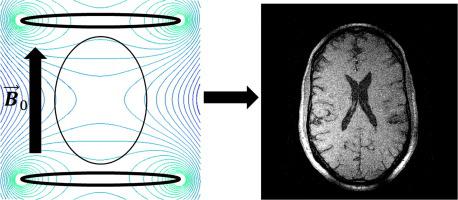当前位置:
X-MOL 学术
›
Prog. Nucl. Magn. Reson. Spectrosc.
›
论文详情
Our official English website, www.x-mol.net, welcomes your feedback! (Note: you will need to create a separate account there.)
Contemporary approaches to high-field magnetic resonance imaging with large field inhomogeneity
Progress in Nuclear Magnetic Resonance Spectroscopy ( IF 6.1 ) Pub Date : 2020-10-01 , DOI: 10.1016/j.pnmrs.2020.07.003 Michael Mullen 1 , Michael Garwood 1
Progress in Nuclear Magnetic Resonance Spectroscopy ( IF 6.1 ) Pub Date : 2020-10-01 , DOI: 10.1016/j.pnmrs.2020.07.003 Michael Mullen 1 , Michael Garwood 1
Affiliation

|
Despite its importance as a clinical imaging modality, magnetic resonance imaging remains inaccessible to most of the world's population due to its high cost and infrastructure requirements. Substantial effort is underway to develop portable, low-cost systems able to address MRI access inequality and to enable new uses of MRI such as bedside imaging. A key barrier to development of portable MRI systems is increased magnetic field inhomogeneity when using small polarizing magnets, which degrades image quality through distortions and signal dropout. Many approaches address field inhomogeneity by using a low polarizing field, approximately ten to hundreds of milli-Tesla. At low-field, even a large relative field inhomogeneity of several thousand parts-per-million (ppm) results in resonance frequency dispersion of only 1-2 kHz. Under these conditions, with necessarily wide pulse bandwidths, fast spin-echo sequences may be used at low field with negligible subject heating, and a broad range of other available imaging sequences can be implemented. However, high-field MRI, 1.5 T or greater, can provide substantially improved signal-to-noise ratio and image contrast, so that higher spatial resolution, clinical quality images may be acquired in significantly less time than is necessary at low-field. The challenge posed by small, high-field systems is that the relative field inhomogeneity, still thousands of ppm, becomes tens of kilohertz over the imaging volume. This article describes the physical consequences of field inhomogeneity on established gradient- and spin-echo MRI sequences, and suggests ways to reduce signal dropout and image distortion from field inhomogeneity. Finally, the practicality of currently available image contrasts is reviewed when imaging with a high magnetic field with large inhomogeneity.
中文翻译:

具有大场不均匀性的高场磁共振成像的现代方法
尽管磁共振成像作为一种临床成像方式很重要,但由于其高成本和基础设施要求,世界上大多数人仍然无法使用磁共振成像。正在大力开发能够解决 MRI 访问不平等问题的便携式低成本系统,并实现 MRI 的新用途,例如床边成像。便携式 MRI 系统开发的一个主要障碍是使用小型极化磁铁时磁场不均匀性增加,这会通过失真和信号丢失而降低图像质量。许多方法通过使用低极化场(大约十到数百毫特斯拉)来解决场不均匀性。在低场下,即使是百万分之几千 (ppm) 的较大相对场不均匀性也会导致共振频率色散仅为 1-2 kHz。在这些条件下,具有必要的宽脉冲带宽,快速自旋回波序列可以在低场使用,对象加热可以忽略不计,并且可以实现范围广泛的其他可用成像序列。然而,1.5 T 或更高的高场 MRI 可以提供显着改善的信噪比和图像对比度,因此可以在比低场所需的时间短得多的时间内获得更高的空间分辨率和临床质量的图像。小型、高场系统带来的挑战是相对场不均匀性,仍然是数千 ppm,在成像体积上变成了数十千赫兹。本文描述了场不均匀对已建立的梯度和自旋回波 MRI 序列的物理后果,并提出了减少场不均匀引起的信号丢失和图像失真的方法。
更新日期:2020-10-01
中文翻译:

具有大场不均匀性的高场磁共振成像的现代方法
尽管磁共振成像作为一种临床成像方式很重要,但由于其高成本和基础设施要求,世界上大多数人仍然无法使用磁共振成像。正在大力开发能够解决 MRI 访问不平等问题的便携式低成本系统,并实现 MRI 的新用途,例如床边成像。便携式 MRI 系统开发的一个主要障碍是使用小型极化磁铁时磁场不均匀性增加,这会通过失真和信号丢失而降低图像质量。许多方法通过使用低极化场(大约十到数百毫特斯拉)来解决场不均匀性。在低场下,即使是百万分之几千 (ppm) 的较大相对场不均匀性也会导致共振频率色散仅为 1-2 kHz。在这些条件下,具有必要的宽脉冲带宽,快速自旋回波序列可以在低场使用,对象加热可以忽略不计,并且可以实现范围广泛的其他可用成像序列。然而,1.5 T 或更高的高场 MRI 可以提供显着改善的信噪比和图像对比度,因此可以在比低场所需的时间短得多的时间内获得更高的空间分辨率和临床质量的图像。小型、高场系统带来的挑战是相对场不均匀性,仍然是数千 ppm,在成像体积上变成了数十千赫兹。本文描述了场不均匀对已建立的梯度和自旋回波 MRI 序列的物理后果,并提出了减少场不均匀引起的信号丢失和图像失真的方法。


























 京公网安备 11010802027423号
京公网安备 11010802027423号